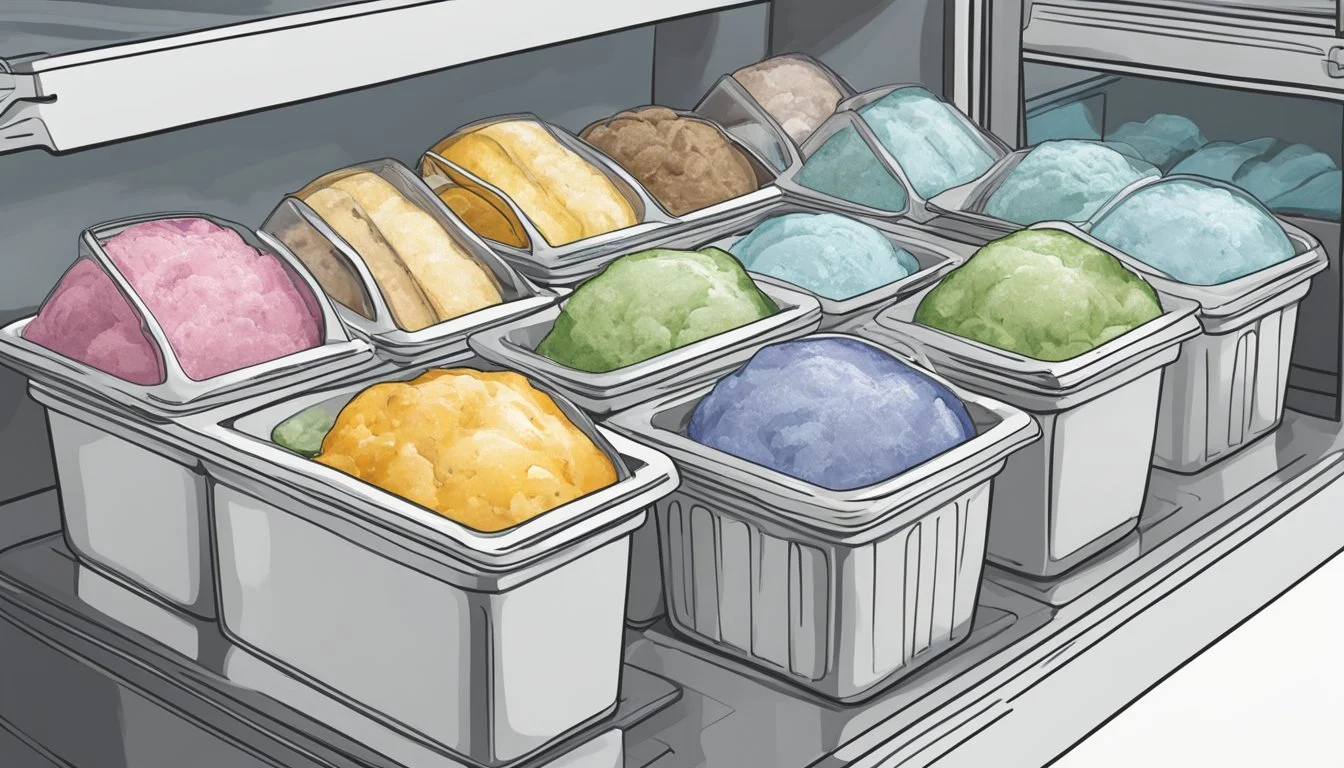How Long Does Gelato Last?
Understanding Its Shelf Life and Storage
Gelato's longevity in the freezer is a topic of interest for those who enjoy this rich and creamy Italian dessert. While similar to ice cream (how long does cream last?) in its frozen state, gelato has a denser texture and a more intense flavor profile, which may lead consumers to wonder about its shelf life. Proper storage plays a crucial role in maintaining gelato’s quality, preventing spoilage and crystal formation that can occur over time.
Typically, when stored at an optimal temperature range of -10 to -15 degrees Celsius (14 to 5 degrees Fahrenheit), gelato can retain its ideal qualities for up to two months. The key to preserving its delicate structure and taste is to keep it at a consistent temperature, minimizing exposure to air and temperature fluctuations that can lead to a diminished sensory experience. For those who seek to enjoy gelato at its best, scooping the dessert while frozen and immediately returning the container to the freezer is recommended.
To achieve the perfect texture for consumption, allowing gelato to soften slightly after scooping can enhance its flavor and mouthfeel. Either placing the scooped gelato in the refrigerator for 15-20 minutes or leaving it on the countertop for a brief period can yield a creamier, more enjoyable texture. This balancing act of temperature control both in storage and prior to serving ensures the ultimate gelato experience.
Understanding Gelato
When embarking on the journey through the world of frozen desserts, it's essential to recognize the distinct qualities that make gelato a remarkable indulgence. From its Italian roots to its creamy texture, understanding gelato requires a comparison to its frozen cousin, ice cream.
Defining Gelato
Gelato is a frozen dairy dessert, originating from Italy, renowned for its smooth, soft texture and intense flavor. It generally contains a higher proportion of milk than cream, which translates to a lower fat content compared to traditional ice cream. Gelato is also churned at a slower rate, introducing less air and resulting in a denser product. Common ingredients of gelato include milk, sugar, flavorings like fruit and nut purees, and sometimes eggs.
Percentages for typical gelato composition:
Milk: 60-75%
Sugar: 16-22%
Fat: 4-8%
Air: 20-30% of volume
Gelato vs. Ice Cream
When comparing gelato to ice cream, there are several key differences:
Fat Content: Ice cream often has a fat content of at least 10%, as it contains more cream. Gelato has a lower fat content, as it relies more on milk.
Texture and Temperature: Gelato is churned at a slower speed, which means less air is incorporated. This creates a denser texture and allows it to be served at a slightly warmer temperature, enhancing its flavor and creaminess.
Flavor: With less fat, gelato doesn't coat the mouth in the same way ice cream does. This allows the flavors to be more pronounced.
Emulsifiers: Many commercial ice creams contain emulsifiers and stabilizers to aid texture and shelf life. Traditional Italian gelato focuses on natural ingredients, often foregoing these additives.
These characteristics of gelato are not just culinary details but are orchestrated carefully to achieve the renowned appeal that this Italian dessert has garnered worldwide.
Storage Fundamentals
Proper gelato storage extends its freshness and preserves its texture and flavor. Attention to temperature control, container choice, and freezer management is essential.
Ideal Storage Conditions
Gelato should be stored in an environment that minimizes temperature fluctuations. The ideal storage temperature for gelato is consistently between -15°C to -18°C (-5°F to 0°F). Maintaining a steady temperature ensures the gelato remains dense, creamy, and free of ice crystals.
Choosing the Right Containers
To store gelato, one should use airtight containers. These can be plastic or glass but must seal well to prevent air exposure. Containers that seal tightly protect the gelato from absorbing odors and guard against freezer burn, which can deteriorate gelato's taste and texture.
Freezer Management
Regularly check the freezer to ensure it operates at the correct temperature and adjust settings as needed. The freezer should not be overpacked, as this can restrict airflow and lead to uneven cooling. Additionally, place the gelato away from the door where temperature variations occur more frequently due to the opening and closing of the freezer.
Maximizing Gelato Freshness
Proper storage is critical to maintaining the quality and extending the shelf life of gelato. By managing temperature precisely, employing effective freezing and thawing strategies, and preventing ice crystal formation, one can preserve gelato's creamy texture and flavor.
The Impact of Temperature on Quality
Maintaining the optimal temperature is essential for preserving gelato's creamy texture. Gelato should be stored at temperatures ranging from -10°C to -20°C (-14°F to -4°F) to prevent degradation. Consistently cold temperatures help in preventing the formation of large ice crystals that can compromise texture and flavor.
Freezing and Thawing Strategies
When freezing, it is important to minimize exposure to air, which can lead to freezer burn. The gelato should be stored in an airtight container to deter the dehydration process. During thawing, placing gelato in the refrigerator for 15-20 minutes before consumption can make it easier to scoop without affecting its texture.
Preventing Ice Crystals
To avoid crystallization, it is crucial to minimize temperature fluctuations. Ice crystals typically form when gelato thaws and refreezes. Opening the freezer frequently can raise the temperature, increasing the risk of crystal formation. One should ensure the gelato returns to the freezer promptly after serving.
Shelf Life Considerations
The longevity of gelato hinges on storage practices and the intrinsic qualities of the dessert. Ensuring gelato remains fresh and retains its flavor requires understanding the elements that influence its shelf life.
Determining Gelato Shelf Life
Gelato typically maintains its best quality for up to two months when stored properly in the freezer. The use by date provided by manufacturers can serve as a guideline, but it’s essential to note that gelato can be consumed past this date if it has been stored under the correct conditions and shows no signs of spoilage.
Factors Affecting Shelf Life
Temperature: Gelato should be kept at a consistent temperature range of -10°C to -15°C (14°F to 5°F) to prevent the formation of large ice crystals, which can affect both texture and flavor.
Air Exposure: Minimizing air exposure by keeping the gelato container tightly sealed helps in preserving its freshness and preventing freezer burn, which could compromise the delicious quality of the gelato.
Storage Practices: Frequent thawing and refreezing can result in a decline in the gelato's fresh and hard consistency. It is recommended to rapidly put the gelato back in the freezer after serving.
Serving and Preservation Tips
When serving gelato, it is important to use the correct techniques to maintain its quality. Proper scooping and serving temperature are crucial to preserve the taste and texture of gelato for the best eating experience.
Proper Gelato Scooping Techniques
To preserve the dense and creamy texture of gelato, one should use a gentle touch. Scooping should be carried out by allowing the natural weight of the scoop to glide through the gelato, which helps avoid compressing it and altering its texture. It is best to rotate the scoop to create clean edges for a presentable serving.
Avoid excessive pressure: This can make the gelato denser and less enjoyable.
Rotational scoop motion: Ensures smoother release and neatly shaped servings.
Serving Temperature Insights
The serving temperature of gelato affects its flavor and hardness. Ideal serving temperatures range from -10°C to -20°C (-14°F to -4°F), where its consistency is not too hard nor too soft, allowing the flavors to be fully appreciated. Here's a brief guide to ensuring optimal serving temperature:
Serving Softness: To achieve a softer serving consistency, place scooped gelato in the refrigerator for 15-20 minutes, or leave it at room temperature briefly before serving.
Temperature Consistency: Keep the gelato at a steady, cold temperature in the freezer to prevent ice crystal formation that can impair taste and texture.
By adhering to these techniques, one can ensure the gelato served is as delightful in flavor and texture as intended.
Health and Safety
The health and safety of consuming gelato is paramount and directly tied to its storage conditions and recognition of spoilage signs. Proper food safety practices are essential to prevent foodborne illness and ensure the highest quality of gelato consumption.
Spotting Signs of Spoilage
Off Odor: A cardinal sign of spoiled gelato is an unpleasant smell that deviates from its original creamy and sweet aroma. If the gelato emits any sour or off odors, it should not be consumed.
Appearance: Gelato that has deteriorated will often have visible changes, such as a discolored surface or the presence of large ice crystals which can indicate freezer burn.
Texture: A gritty texture or the presence of melted ice re-solidified can indicate that the gelato has undergone temperature variations and may be unsafe to eat.
Food Safety Practices
Storage Temperature: Gelato should be stored consistently at -10°C to -20°C (-14°F to -4°F) to minimize the risk of spoilage and maintain quality.
Freezer Burn Prevention: To prevent freezer burn and off odors, gelato should be tightly sealed in its container, limiting exposure to air which can dehydrate the surface and compromise flavor and texture.
Time Out of Freezer: For health safety, gelato should not sit out at temperatures above 40°F for more than 2 hours. Otherwise, there is a risk of bacterial growth, and it should be discarded.
Enjoying Gelato
Gelato, with its rich flavors and creamy texture, provides an exquisite dessert experience. When indulging in gelato, selecting the right flavor is crucial, and crafting homemade versions offers a customizable treat.
Selecting Flavors
Selecting the perfect gelato flavor is subjective and depends on individual preferences. Traditional options like chocolate, vanilla, and strawberry are perennial favorites. However, gelato artisans often offer an array of unique flavors that may include regional fruits, herbs, or nuts. When choosing flavors, consider the balance of sweetness and intensity; some flavors may be robust and rich, while others are delicate and subtle.
Classic Flavors Fruit Flavors Specialty Flavors Chocolate Strawberry Salted Caramel Vanilla Lemon Hazelnut Pistachio Raspberry Tiramisu
Homemade Gelato Basics
Making homemade gelato begins with a basic recipe consisting of milk, cream, sugar, and egg yolks. Unlike homemade ice cream, gelato typically has a lower fat content and less air, resulting in a denser texture. Aspiring gelato makers can experiment with natural flavors by infusing the base with fruits, nuts, or other ingredients. Avoiding preservatives and corn syrup not only ensures a purer taste but also gives control over the sweetness and nutritional content.
A simple base recipe may involve gently heating milk and sugar, then slowly incorporating beaten egg yolks, followed by cream. Incorporating the chosen flavors at the correct stage of the recipe is crucial; for example, chocolate should be melted into the base, while fruit purees are often added later. Once churned and frozen, homemade gelato offers a fresh and authentic taste that showcases the maker's skill and creativity.








